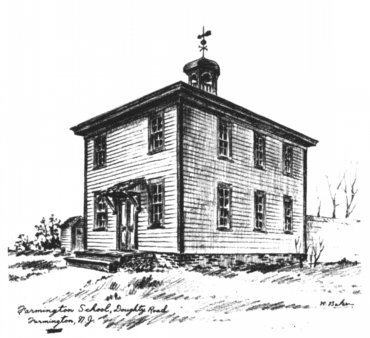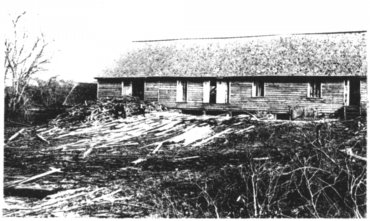|
In 1892, Jonathan Casper Adams and Elizabeth
Jane, his wife, built a home on a ten-acre
tract. Other families living in the area were
Benjamin C. Lear and wife, Winfield T. Ireland
and wife, William Hauenstein and family, Absolum
Connelly and wife, John Kruger and wife, William
T. Martin and family, Frank Martin and wife,
Mrs. Mary Ney Adams, Rudolph King and wife,
Andrew Fitzpatrick and wife, Mrs. Smith, Hosea
Mannery and wife, and Mr. and Mrs. Richardson.
The first Negro family to join the community
was named Montague. Their house is still standing.
It was first decided to call the town "Marytown"
after the numerous housewives named Mary,
but the men held a meeting and finally chose
the name "Farmington" because it
was farmland where the homes stood, the rest
of the surrounding area being woodland. A
sign proclaiming "Farmington" was
placed on the Reading Railroad Way Station,
which was only a wooden platform about three
feet high and "Farmington" was added
to the list of towns on the train timetables.
The "accommodation train" was stopped
by flagging at six and nine o'clock in the
morning and four and seven o'clock in the
afternoon and evening.
Fire Road was originally a fire lane, intended
to be ninety feet wide but was only a narrow
sand road for many years until relatively
recently improved.
Farmington was in great need of a school
as the children had to attend Pleasantville
or Smith Landing Schools. The one room school
house was organized by William Hauenstein,
J. Casper Adams and Benjamin Lear . Martin
Lear, son of Benjamin Lear, donated land situated
on Doughty Road and the school was erected
about 1893. The first teacher was a young
man named Wm. Stafford from Pennsylvania,
followed in order by Miss Nedora Risley, Miss
Olive Myers, Miss Nellie Ireland, Miss Julia
Price, Charles P. Campanella, Miss Tillie
Grams, Mrs. J. Hazelton, Thos. McConnell,
Maurice H. Taylor, Chas. W. Ingersoll, Eugene
Scull (still living in Scullville), Misses
Sara Eccles, Ruth Glendenning, Ella Adams,
Mrs. Sara Runear, Mrs. Marguerite Strickland,
Mrs. Curtis Adams and so on, until the new
school was built at the instigation of Jarvis
J. Maxwell then a member of Egg Harbor Township
school board and James B. Brown, another member,
about 1926 or 1927. George Sutton bought the
old school building and had it moved across
Doughty Road in 1935 where it stands remodeled
and known as Farmington Community Church and
Sunday School.
 |
The Farmington School
House on Doughty Road was built about
1893, and used as a school until 1935.
In that year it was bought by George
Sutton and moved across the Road from
a new school. It is now the Farmington
Community Chapel and Sunday School.
|
At one time the men of Farmington organized
a Farmers Union and met in a building on Fire
Road next to the Reading Railroad on the tract
known then as Johnson's Field. After the Farmers
Union was disbanded, the building was bought,
moved and placed facing Doughty Road. Johnson's
Field was named for an old runaway slave who
lived, died and was buried there. Marshall
Field at the intersection of Delilah and Doughty
Roads was also named for a runaway slave who
found asylum there.
What is mostly the National Aviation Facilities
Experimental Center now was once owned by
General Enoch Doughty and was known as Doughty's
Mill. There was a beautiful manor house, a
gristmill, sawmill, a chapel, a cabin and
a row of small cottages for the men and their
families, who worked in the mills and tended
the charcoal pits along the stream, Ingersoll's
Branch also known as Stony Brook or Little
Brook. Charcoal was made here and carted by
mule teams to Atlantic City. The wooded section
was known as Charcoal Hill. The native Pixie
plant found only in Southern New Jersey and
Trailing Arbutus abounded at Charcoal Hill.
 |
Saw
Mill building at Doughty's. The Map
of Atlantic County made in 1872 by
Beers, Comstock & Cline locate
the sawmill at Doughty's south pond
as shown on the sketch of Farmington.
( Photo by H.K. Anderson from a
negative from Robert McMullin, Absecon,
N. J)
|
In 1902, a portion of Farmington and Doughty
Mills was bought from the Doughty Estate by
Victor Humbroke and William Oakes of North
Jersey and developed as Pleasantville Terrace.
Several houses were built there and a pretty
little railroad station bearing the name of
Pleasantville
Terrace above the station door. Five
of the original houses are still being used
today. The Station house was moved from its
first location on the railroad to where it
stands now as Burgy's Inn.
About 1902, a Jewish Cemetery was dedicated
on the Western side of Fire Road and Delilah
Road and enclosed with a fence and iron gates.
After a few years it was moved to Fire Road
and Reading Railroad, opposite the Railroad
Station on the south side and later was again
moved to Pleasantville. In the early 1900's,
Mt. Calvery Cemetery was a lovely burial ground
with a wide tree lined driveway from the train
stop platform on the West Jersey Railroad
to a chapel in the middle of the cemetery.
In 1938, the Farmington Fire Company was
first formed and elected officers on April
26th. The Ladies Auxiliary met and elected
officers on May 31st of that year.
The more than 150-year-old homestead of Mary
Ney Adams still stands on Delilah Road and
is owned by George and Rose Price of Northfield.
One must tell of the legend of Stony Brook.
In back of Charcoal Hill, there was one spot
that seemed bottomless and with a whirlpool
to make it seem even more dangerous and sinister.
The devil, himself, was rumored to live in
its depths. When men and their dogs were out
hunting for the Devil and came near to this
whirlpool, the dogs dropped dead. This spot
became known as Dog Heaven. The footbridge
used over that particular portion of the stream
disappeared some thirty years ago and is probably
forgotten by many and never known by most.
Farmington today has become a town of highways
and lovely buildings--a far cry from the little
settlement of the late 1800's.
|


